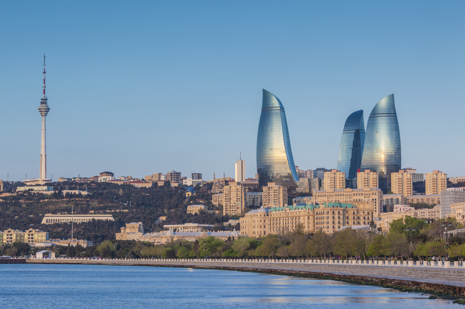
By Marie Owens Thomsen, IATA Senior Vice President Sustainability & Chief Economist
The UNFCCC COP process is crucial for accelerating action to tackle the climate crisis, especially with global temperatures hitting record highs and extreme weather events affecting people worldwide. It brings together leaders from governments, businesses, and civil society to advance concrete solutions. COP29 was held in Baku, Azerbaijan, for two weeks from 11-22 November and hosted an estimated 66,000 participants in the “Blue Zone” - the official negotiating space.
COP29 was designated as the “finance COP” due to the critical negotiations planned around the so-called “new collective quantified goal” (NCQG) on climate finance. Meeting the Paris Agreement’s goal to limit global warming requires developed nations to lead by increasing climate support for developing countries. NCQG negotiations focused on agreeing on a new quantified goal for climate finance from developed to developing countries, increasing from the previous $100 billion a year (set in 2009 at COP15, Copenhagen). This USD$100 billion goal was repeated in the 2015 Paris Agreement but was now seen as inadequate to meet the needs of developing countries to deal with climate change.
COP29 called for major economies to commit to stronger national climate targets and climate finance commitments to support developing nations.
IATA followed the process and provided input into two streams of negotiations relevant to aviation by engaging with key parties and other stakeholders within and outside the aviation sector.
Following tense discussions, a major breakthrough was the adoption of the NCQG with the agreement to triple climate finance from developed to developing countries, increasing the annual goal from USD$100 billion to USD$300 billion per year by 2035, principally through public sources of finance. (i.e., grants, low-interest loans).
This amount would form a “core” and “catalytic” part of a larger $1.3 trillion a year ambition for climate finance flows to developing countries from all public and private sources (including from developing countries) by 2035. The funds aim to help developing countries to protect themselves against climate disasters and to participate in the clean energy transition.
Parties will now negotiate to identify these financial sources, and the “Baku to Belém Roadmap to 1.3T” was launched to aid this process, and significant work will be done in the lead-up to COP30.[1]
Article 6 of the Paris Agreement establishes a framework for countries to cooperate voluntarily among themselves in meeting the national climate targets set in their nationally determined contributions (NDCs), thereby allowing for higher ambition in their mitigation and adaptation actions. This is to be achieved through the use of internationally transferred mitigation outcomes (ITMOs; where 1 ITMO = 1 metric tonne of carbon dioxide equivalent).
Article 6 contains three pathways for cooperation, including ITMO transfers (Article 6.2), a centralized carbon crediting mechanism (Article 6.4), and non-market approaches (Article 6.8). Article 6.2 covers the rules for transferring ITMOs for use toward NDCs or other international mitigation purposes, such as the Carbon Offsetting and Reduction Scheme for International Aviation (CORSIA), while Article 6.4 creates a centralized system to replace the Clean Development Mechanism (CDM – from the Kyoto Protocol). Both Article 6.2 (rules on transfer of ITMOs, particularly on avoidance of double claiming) and Article 6.4 (sustainability and environmental integrity standards of carbon offsets participating in the Mechanism) have implications for aircraft operators under CORSIA and jointly contribute to determining the supply of CORSIA Eligible Emissions Units (EEUs) and their environmental integrity.
IATA conducted joint efforts with the International Civil Aviation Organization (ICAO), the UN specialized agency for international aviation that is responsible for managing emissions from international aviation[2], to highlight the industry’s robust participation in CORSIA – the only global market-based mechanism that allows airlines to invest in carbon projects and reduce the sector’s emissions. Only one host country, Guyana, has issued their authorizations for the use of ITMOs toward air transportation’s international mitigation purposes so far. However, following decade-long negotiations, significant progress on this front was also achieved at COP29, following agreement on open items in both Article 6.2 and 6.4, resulting in full operationalization of the cooperative approaches under Article 6. Some significant outcomes in this stream include:
At COP29, IATA, together with Article 6 Implementation Partnership (A6IP), International Emissions Trading Association (IETA), and the Air Transport Action Group (ATAG), produced a Guidance Document for Host countries concerning the issuance of CORSIA Eligible Emissions Units (EEUs) (pdf). This provides UNFCCC States with a comprehensive overview of CORSIA emissions unit criteria, highlighting their responsibility to implement corresponding adjustments to guarantee the environmental integrity of CORSIA EEUs. It outlines the essential steps involved in issuing a Letter of Authorization and applying corresponding adjustments, considering the recently adopted operational rules of Article 6 of the Paris Agreement. A Letter of Authorization template (pdf) is also available. Both will be updated shortly to reflect the outcomes of COP29.
Reaching net zero CO2 emissions by 2050 is feasible, but solving the aviation industry’s energy transition cannot only be seen as a transport issue. All forms of transportation, including aviation, are indispensable for any country’s economic development, and all are integral to the global energy transition. To this effect, IATA’s three key messages at the event were as follows:
In addition to closely monitoring and influencing the official negotiations, over the course of the two weeks, IATA hosted two separate events (on CORSIA and carbon removals), participated in several formal presentations and panel discussions, and engaged with senior government officials as well as industry and other stakeholders from around the world in more than a dozen separate bilateral meetings.
For more information, please check out the videos recorded during the event:
[1] Para. 27 of NCQG text; COP30 will be held in Belém, Brazil
[2] Article 2.2 of Kyoto Protocol